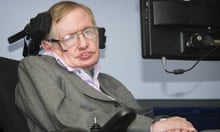I first encountered Stephen Hawking on the cover of the New York Times magazine. Inside, its pages told a story we all know today, but at the time it was a revelation: a Cambridge astrophysicist sought to solve the great mysteries of the universe, while he himself was trapped in a wheelchair by a progressive neurogenerative disease. I remember being struck by writer Timothy Ferris’s description of Professor’s Hawking’s shoes, their soles pristine, having never touched the ground. I tucked the article in my knapsack, and a few days later I finished reading it on my way to lunch with a literary agent.
In one of those remarkable moments of serendipity, during lunch I mentioned the article to agent Al Zuckerman, who told me he was already trying to reach Professor Hawking to see if he might be interested in writing a popular book. Some months later I received a submission from Al — a short manuscript and an invitation to participate in an auction for the publishing rights to A Brief History of Time.
At the time I was a senior editor at Bantam Books, which was an unlikely home for Prof Hawking’s book, given the number of prestigious, traditional publishing houses in the hunt to acquire it. However, Bantam’s experience selling popular paperbacks meant that its distribution went far beyond bookstores into drugstores, supermarkets, and airport shops. I sent a letter to Professor Hawking along with our financial offer, making the case that Bantam could get his book in the hands of the widest possible readership. It turned out that he was the rare academic who wanted just that — to bring his esoteric scholarly work to the attention of the masses. He chose us.
A few months later Stephen Hawking came to the US from Cambridge to give a lecture at Chicago’s Fermi Institute, so I arranged to meet him afterwards at the Holiday Inn, where Stephen was staying. As I turned into the parking lot, another car pulled up nearby. A young man got out, opened the trunk, unfolded a wheelchair, and placed a large battery underneath it. Then he opened the passenger door and gently scooped up a thin figure, and arranged him in the wheelchair. As I got out of my car he shouted, “Is that Peter Guzzardi? This is Professor Hawking,” just as the wheelchair spun a full 360 degrees and rocketed in the direction of the hotel lobby, with Stephen’s assistant and me in full pursuit.
When we convened in Prof Hawking’s room, I introduced myself, and asked politely if his flight from London had been comfortable. Stephen responded with a brief series of undecipherable sounds, which his assistant, a physics graduate student named Brian Whitt, translated. “Prof Hawking wants to know if you brought the contract.” So much for small talk. I produced the legal document, and Brian held it up, page by page, for Stephen to read, which he did at breathtaking speed. His body might be largely beyond his control, but his mind was obviously in hyper-drive.
Since Stephen didn’t yet have a publisher in the UK, the job of editing the English language edition of A Brief History of Time fell to me. I won’t pretend that it wasn’t a challenge. The manuscript was a slender but extremely dense 100 pages, describing the quest for the holy grail of science – one theory that could unite two separate fields that worked individually but wholly independent of each other. Particle physics explained the ghostly forces at work within atoms, whereas astrophysics made sense of massive effects like gravity that operated at the level of galaxies and star systems. As Stephen would so poetically put it, if scientists could come up a grand unified theory that explained both these fields we would truly understand everything: we would finally “know the mind of God.”
At the time, however, our goal was far more modest. We were just trying to create a book that was scientifically accurate without being impenetrable to the general reader, someone like me. My primary contribution to the book was to doggedly keep asking Stephen questions, not giving up until I understood what he intended to convey. That process took many months of correspondence, interrupted by a medical crisis that led to the tracheotomy that saved Stephen’s life, but left him unable to speak at all. Thanks to his fierce determination and some remarkable computer software, Stephen was able to continue working on the book, and he eventually completed the final draft in the fall of 1987.
The rest, as they say, is history. A Brief History of Time sold out its first US printing in a matter of days, became a #1 bestseller around the world, was translated into more than 35 languages, and went on to sell more than 10 million copies. More importantly, it continues to make generations of readers aware of the ongoing quest to come up with the Grand Unified Theory of Everything. I’m honoured to have played a role in the publication of A Brief History of Time, and to have known, worked with, and befriended the brilliant, inspiring man who wrote it.









